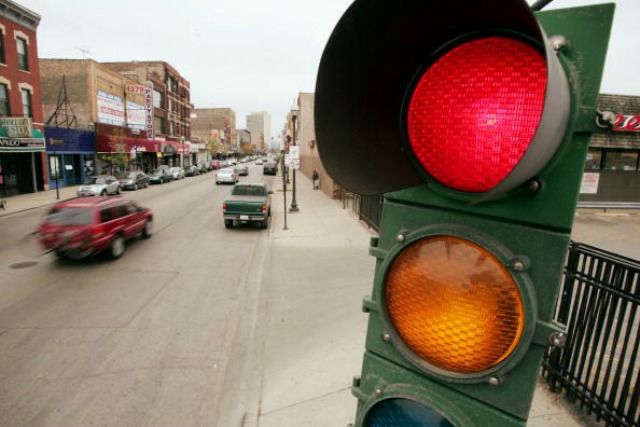Chicago Drivers Are Getting A Bit More Leeway On Running Red Lights
By Stephen Gossett in News on Mar 20, 2017 9:01PM

Chicago street light / Getty Images / Photo: Scott Olson
Today looks like it was a win for both advocates of safe streets and opponents of nickel-and-dimed revenue generation. The city announced that it would raise the grace period for cars passing through a red light—to the joy of Chicago drivers—while keeping that grace period at a safe and reasonable length—to the joy of Chicago pedestrians who enjoy remaining in one piece while crossing an intersection.
Following a recommendation from a report by the Northwestern University Transportation Center on red light camera enforcement, the city of Chicago extended the grace period for issuing a ticket from 0.1 seconds to 0.3 seconds after a light hits red. That threshold represents the sweet spot, where the intersection is still kept safe but the ticketing remains fair.
“The safety of motorists, pedestrians and bicyclists is our top priority and I am pleased that this comprehensive report confirms the beneficial safety impact of Chicago’s Red Light Camera program,” said Chicago Department of Transportation (CDOT) Commissioner Rebekah Scheinfeld in a press release. “The goal now is to continue our ongoing effort to increase transparency and accountability for the program by embracing the study’s recommendations.”
And what a difference two tenths of a second makes. According to the Sun-Times, nearly 30 percent of red lights that were issued last year fell between the 0.1 and 0.3 range. But don't try to push it, warns CDOT.
“We want to emphasize that extending this enforcement threshold is not an invitation to drivers to try to beat the red light,” Scheinfeld said. “By accepting the recommendation of the academic team, we are giving the benefit of the doubt to well-intentioned drivers while remaining focused on the most reckless behaviors.”
In addition to the grace-period recommendation, the study also pointed out six intersections at which the cameras didn't produce the intended safety boon, plus five that could use them. Those recommendations—upon which the city is also acting—are as follows.
Intersections with cameras to be removed:
· 95th Street & Stony Island Avenue (2 cameras)
· Western Avenue & 71st Street (2 cameras)
· Western Avenue & Pershing Road (2 cameras)
· Grand Avenue & Oak Park Avenue (2 cameras)
· Irving Park Road & Kedzie Avenue (2 cameras)
· Peterson Avenue & Pulaski Road (2 cameras)
Intersections where cameras are proposed:
· Wacker Drive & Lake Street (2 cameras)
· Michigan Avenue and Jackson Boulevard (2 cameras)
· Dearborn Avenue & Grand Avenue (2 cameras)
· Central Avenue, Foster Avenue, Northwest Highway & Milwaukee Avenue (4 cameras)
· Pershing Road and Martin Luther King Drive (2 cameras)